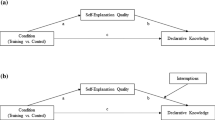Abstract
While smartphones and tablets increasingly offer the possibility to act as healthcare devices, older adults, who may benefit from these new technologies, might be left behind due to technological illiteracy and lack of proper instructions. This study documents an experiment to evaluate and compare different instructional methods to teach older adults to perform a task on a smartphone. Although we did find that older adults were able to learn, no significant differences between instructional methods were found, and retention period is not known. The qualitative analysis suggests some influence of the users’ initial perception of task difficulty over task performance.
Chapter PDF
Similar content being viewed by others
References
Rogers, W.A., Campbell, R.H., Pak, R.: A Systems Approach for Training Older Adults to Use Technology. In: Communication, Technology, and Aging: Opportunities and Challenges for the Future, pp. 187–208. Springer, New York (2001)
Mykityshyn, A.L., Fisk, A.D., Rogers, W.A.: Learning to Use a Home Medical Device: Mediating Age-Related Differences with Training. Human Factors 44(3), 354–364 (2002)
Mitzner, T.L., Fausset, C.B., Boron, J.B., Adams, A.E., Dijkstra, K., Lee, C.C., Rogers, W.A., Fisk, A.D.: Older Adults’ Training Preferences for Learning to Use Technology. Human Factors and Ergonomics Society Annual (2008)
Leung, R., Haddad, C.T., Mcgrenere, J., Graf, P., Ingriany, V.: How Older Adults Learn to Use Mobile Devices: Survey and Field Investigations. TACCESS 4, Article 11 (2012)
Leung, R., Findlater, L., McGrenere, J., Graf, P., Yang, J.: Multi-Layered Interfaces to Improve Older Adults’ Initial Learnability of Mobile Applications. TACCESS 3, Article 1 (2010)
Rogers, W.A., Fisk, A.F., Mead, S.E., Walker, N., Cabrera, E.F.: Training Older Adults to Use Automatic Teller Machines. Human Factors 38, 425–433 (1996)
Struve, D., Wandke, H.: Video Modeling for Training Older Adults to Use New Technologies. TACCESS 2, Article 4 (2009)
Sauro, J., Dumas, J.S.: Comparison of Three One-Question, Post-Task Usability Questionnaires. In: Proceedings of the SIGCHI Conference on Human Factors in Computing Systems, pp. 1599–1608. ACM, New York (2009)
Correia de Barros, A., Cevada, J., Bayés, À., Alcaine, S., Mestre, B.: User-Centred Design of a Mobile Self-Management Solution for Parkinson’s Disease. In: 12th International Conference on Mobile and Ubiquitous Multimedia, Article 23, ACM, New York (2013)
Correia de Barros, A., Leitão, R.: Young Practitioners’ Challenges, Experience and Strategies in Usability Testing with Older Adults. In: Encarnação, P., Azevedo, L., Gelderblom, G.J., Mathiassen, N. (eds.) Assistive Technology: From Research to Practice, AAATE 2013, pp. 787–792. IOS Press, Amsterdam (2013)
Rubin, J., Chisnell, A.L.: Handbook of Usability Testing: How to Plan, Design and Conduct Effective Tests. Wiley Publishing, Inc., Indianapolis (2008)
Fisk, A.D., Rogers, W.A., Charness, N., Czaja, S.J., Sharit, J.: Designing for Older Adults: Principles and Creative Human Factors Approaches. CRC Press, Boca Raton (2009)
Author information
Authors and Affiliations
Editor information
Editors and Affiliations
Rights and permissions
Copyright information
© 2014 Springer International Publishing Switzerland
About this paper
Cite this paper
Ribeiro, J., Correia de Barros, A. (2014). Efficiency of a Video and a Tutorial in Teaching Older Adults to Interact with Smartphones. In: Stephanidis, C., Antona, M. (eds) Universal Access in Human-Computer Interaction. Aging and Assistive Environments. UAHCI 2014. Lecture Notes in Computer Science, vol 8515. Springer, Cham. https://doi.org/10.1007/978-3-319-07446-7_4
Download citation
DOI: https://doi.org/10.1007/978-3-319-07446-7_4
Publisher Name: Springer, Cham
Print ISBN: 978-3-319-07445-0
Online ISBN: 978-3-319-07446-7
eBook Packages: Computer ScienceComputer Science (R0)




